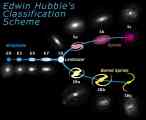
The Hubble "Tuning Fork" diagram. Hubble's classification system for Galaxies. Generally, galaxies evolve from right to left. Click to enlarge. Gérard de Vaucouleurs introduced an extension to the Hubble system in 1959 to provide a more detailed morphology. It is the extended system that we use on the following pages.
Galactic Origins
Recent observations have given cosmologists new insights into how galaxies evolve on cosmological time-scales. The universe appears much the same today as it did around 5 billion years ago. Prior to that, spiral galaxies appear much less evolved with less distinct arms, and many fewer barred spirals. Going even further back, galaxy mergers and interactions seem to happen more frequently, and there appear to be many more irregular galaxies. It seems that, once the Universe was around a few hundred million years old, clouds of hydrogen and helium gas began to condense due to the gravitation field of clumps of dark matter. Small irregular galaxies formed first and, through interaction and merger, formed the larger galaxies we see today. This is not a hard and fast rule as some very large galaxies have been observed in the early universe.
In the past, there have been two basic models for how galaxies formed; top-down and bottom-up.
Top-Down Model
The top-down model proposes that galaxies formed from huge gas clouds that collapsed by gravity. The rate of rotation of the cloud determined the type of galaxy; slow rotation producing elliptical galaxies, faster rotation producing spiral or lenticular galaxies. Very large clouds could fragment to produce multiple clouds, each producing a galaxy. This would explain the clustering and superclustering of galaxies.
Bottom-Up Model
The bottom-up model proposes that smaller clouds produced individual stars and groups of stars that merged to form galaxies and. later, these grouped to form the clusters we see today. Most astronomers accept that the formation process was driven by clumping of dark matter that causes the formation of giant gas clouds early in the evolution of the Universe. Thus, the bottom-up model tends to be favored with dark matter as the engine.
An important consideration in galaxy formation is collisions between galaxies. Considering their size, galaxy spacing is not great. The Milky Way and Andromeda are about 2½ million light-years apart, but each galaxy is about 100,000 light-years across so the spacing is only about 25 galaxy diameters. In the very early, much smaller, Universe, collisions must have been commonplace. There are a number of small galaxies orbiting our Milky Way that are being torn apart and may, ultimately, be absorbed. These collisions take place over tens of millions of years or more, and interaction of gas clouds within the galaxies can cause massive new star formation resulting is what is known as a starburst galaxy. The objects we see furthest from us that are, therefore, the oldest. These are the Quasars, which I discuss in the section on Active Galaxies.
In the past, there have been two basic models for how galaxies formed; top-down and bottom-up.
Top-Down Model
The top-down model proposes that galaxies formed from huge gas clouds that collapsed by gravity. The rate of rotation of the cloud determined the type of galaxy; slow rotation producing elliptical galaxies, faster rotation producing spiral or lenticular galaxies. Very large clouds could fragment to produce multiple clouds, each producing a galaxy. This would explain the clustering and superclustering of galaxies. Bottom-Up Model
The bottom-up model proposes that smaller clouds produced individual stars and groups of stars that merged to form galaxies and. later, these grouped to form the clusters we see today. Most astronomers accept that the formation process was driven by clumping of dark matter that causes the formation of giant gas clouds early in the evolution of the Universe. Thus, the bottom-up model tends to be favored with dark matter as the engine. An important consideration in galaxy formation is collisions between galaxies. Considering their size, galaxy spacing is not great. The Milky Way and Andromeda are about 2½ million light-years apart, but each galaxy is about 100,000 light-years across so the spacing is only about 25 galaxy diameters. In the very early, much smaller, Universe, collisions must have been commonplace. There are a number of small galaxies orbiting our Milky Way that are being torn apart and may, ultimately, be absorbed. These collisions take place over tens of millions of years or more, and interaction of gas clouds within the galaxies can cause massive new star formation resulting is what is known as a starburst galaxy. The objects we see furthest from us that are, therefore, the oldest. These are the Quasars, which I discuss in the section on Active Galaxies.


